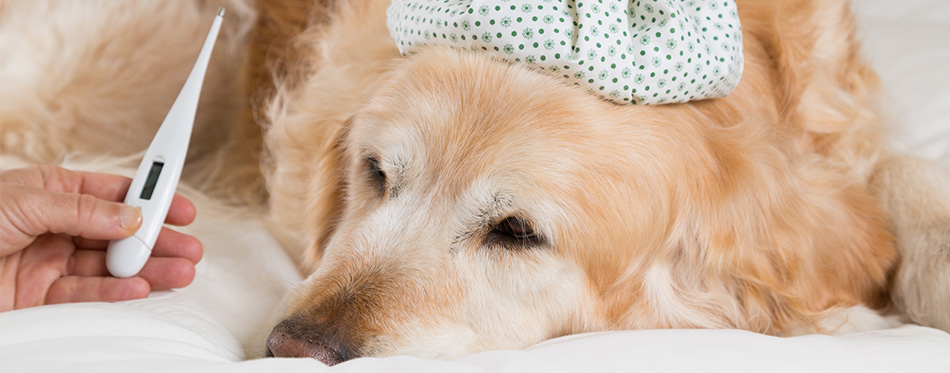Just like humans, a dog with abnormally high body temperature is a sign of a health problem. This is usually accompanied by other signs and symptoms such as lack of energy, depression, and loss of appetite. So, how can you tell if a dog has a fever? There is only one sure way, and that is to take its body temperature. Unfortunately, most owners do not know how to take the temperature; and that’s what this article seeks to expound.

Understanding Dog Fever
What is a dog’s normal temperature? Before you dive into the ins and outs of dog fever, it is essential to understand that a dog’s normal body temperature is usually higher than that of humans. While any temperature above 99.60F would signal danger in humans, your furry friend will be said to have a fever only when the temperature is above 103 0F. This means that even when you feel that your pet’s temperature is warmer than your skin; it doesn’t necessarily imply that they have a fever.
If it is above 1060F, your canine friend is severely sick, and a little delay would lead to its demise. Regardless, any temperature that exceeds 103 degrees Fahrenheit should be considered as an indication of possible inflammation or infection. Sometimes the temperature might be higher than usual if the dog has been out there playing or exercising in humid and hot conditions. When the weather is scorching, your pet might have an abnormally high body temperature, making you conclude that it has a fever. This is usually referred to as hyperthermia or heat stroke.
Causes of Dog Fever
Several illnesses and conditions might result in your dog having a fever. They include:
- Vaccination
A low-grade fever that lasts 24 to 48 hours is expected after immunization. This is due to the interaction between the dog’s immune system and the injection.
- Infection
This might be caused by bacterial, viral or fungal diseases. The infection could be anywhere in the body, such as the kidneys, skin, brain or the lungs. The symptoms experienced depend on the location of the infection. Some infections such as fungal diseases can affect several body parts at a go.
- Toxins
When a dog consumes a substance that is toxic to its species, it is likely to have increased body temperature. The toxic substances include human antidepressants and macadamia nuts.
Sometimes the real causes of dog fever are unknown, and it can be referred to as fever of unknown origin. The likely causes of such fever include cancer, disorders of the immune system, undiagnosed infections and bone marrow problems.
Symptoms of Fever in Dogs
Elevated temperatures are an indication that the body is under attack and it is trying to fight the infection. Therefore, fever is an act of defense in that the body has recognized a foreign organism like virus or bacteria and it is fighting back. When your furry friend is affected by fever, it is likely to exhibit these symptoms:
- Does not want to eat, or eats very little food, even when it is its favorite meal
- Depressed mood or appears less energetic than usual. It might also refuse to play, swim or engage in any activity
- Vomiting that is accompanies by thick mucus
- Shivering even when the temperatures are warm
- Coughing and nasal discharge
However, these cues are subjective and cannot help you make a conclusive assessment of the dog’s actual condition. That is why taking the core body temperature is advisable.
How to Take Your Dog’s Body Temperature Using Dog Thermometers

How Can You Do It Best?
When assessing your pet’s body temperature, you should appreciate that the most accurate way of doing it is by inserting the dog thermometer into its rectum, particularly the conventional glass type.
Rectal thermometers give accurate readings because the blood vessels inside the rectum walls are closer to the body more than those in the armpit. The warmth generated by the body is distributed evenly throughout the body. The closer the thermometer gets to a network of blood vessels, the more accurate the reading shall be.
How to Improve the Accuracy of Non-Rectal Temperature Readings
- You can increase the length of time for the thermometer to sense the temperature
- You can also use a thermometer with a more sensitive probe
A Step-By-Step Guide on How to Take Your Dog’s Temperature
Get Some Assistance
Dogs do not fancy having their buts touched, leave alone having a probe inserted in there. When they feel uncomfortable, they squirm, making it hard for you to insert the thermometer. That is why you should ask someone else to help you keep the pet occupied as you put in the probe. The other person can help your dog chew a treat. If you are not comfortable with the “rear” job, you may switch places.
Find out more about Vegan Dog Treat and Dog Chew here.
Prepare Your Materials
There isn’t much to prepare rather than having an accurate digital rectal thermometer. When buying one of these, ensure that it is for rectal use and not for armpit or auxiliary use. You should also get a fast-reading thermometer because the longer you keep the device in your pet’s butt, the more stressed your pet will become. If there is a device that can get an accurate reading in 3 seconds, you should get it by all means. Make sure you have dog treats to reward your canine friend when you are done taking the temperature.
Disinfect and Lubricate the Thermometer
Have rubbing alcohol and cotton balls with you to disinfect the thermometer. Once you have your thermometer clean and ready for use, the next step is to lubricate its tip to enable lubrication. Water-based lubricants are ideal, but petroleum jelly should do fine.
Insert the Thermometer
- For conventional glass type
With your dog’s focus entirely on the treats being given to it, grab its tail and move it gently upwards to have a view of its anus. Lubricate the probe and introduce it into the opening of the anus until you feel some resistance. At this point, you have reached the internal anal sphincter and beyond that is the rectum. As such, you need to push all the way in past the resistance. For large dogs, you will need to put in approximately three inches of the thermometer. For smaller breeds, you may have to insert an inch of the tip into their rectum.
Ensure that the thermometer stays in the rectum for not less than three for guaranteed accuracy.
- For digital type
Turn the thermometer on and let it calibrate before using it. Most digital thermometers will beep when fully calibrated and ready to use. No lubrication is needed when inserting it in the ear canal, but for the rectal route, you have to calibrate. If you are using it on the ear, do not force the device into the canal if your pet dog resists, because it might be painful.
Wait until the thermometer beeps or emits any signal. From there, you can remove it and take the reading.
Reward Your Pet
Do not forget to reward your canine friend afterward. It will not only leave an impression that you liked its behavior, but it will also be happy to cooperate the next time you wish to measure their temperature.
Caring for your pet includes knowing how to ascertain if it has a fever or not. The steps provided here can also be applied when using the auxiliary method. You will, however, require a different kind of thermometer for that. Remember to be gentle when taking the temperature of your furry friend.

How to Take a Dog’s Temperature Without a Thermometer
- Feel the dog’s nose
The dog’s nose can be wet or dry, or cold or warm depending on environmental conditions. For instance, it can be dry when lying under the sun or after exercising. However, in other cases, it can become dry because of dehydration, which is extremely dangerous for canines.
When you feel your pet’s nose, and you notice that it is dry and warm, look out for a greenish discharge. These are signs of an infection like an upper respiratory illness. If it has a fever too, chances of a disease or inflammation are possible.
- Check the dog’s gums
To access the dog’s temperature, look out for warm and dry gums. If this is accompanied by increased body temperatures, chances of an infection are high. When the gums are redder than usual, it might be a sign of fever, an ongoing infection, or septicemia.
- Feel your pet’s paws and ears
A dog with increased body temperature will feel hot in their ears and paws. You can tell when their temperature is above the normal by using your body parts that are sensitive to heat such as the cheeks and the back of the hands. Use your cheeks to feel his ears or paws. If the temperature is way hotter than yours, it might be a sign that it is unwell.
- Feel the groins and armpits
Just like humans, the groins and armpit areas of a dog are warmer than other body parts when it has a fever. The reason is that the regions have lymph nodes and might be filled with immune cells and antibodies, making them warmer than the other areas. Also, these areas are exposed because they lack fur, making it easy and fast to assess them for temperature changes.
- Observe the pet’s behavior and appearance
You can gauge whether your dog is feeling well based on its behavior and appearance. If your dog is used to being lively and playful then suddenly they are sluggish and weak, they might be ill. Note that a dog that seems weak, thirsty or ever sleepy might be dehydrated. Give him lots of fluids orally. If this doesn’t change, seek medical assistance.
- Look out for other signs of fever besides the temperature
If your dog has a fever, he might show other warning signs besides changes in temperature. They include fatigue, extreme weakness, diarrhea, and vomiting. These symptoms indicate that your pet dog is sick. Therefore, consider bringing the dog to a vet clinic as soon as possible.

What to Do When Your Dog’s Temperature Is Higher or Lower Than Normal
If you notice abnormal high and low-temperature readings, make sure you double check before taking any action. Falsely elevated or decreased temperature occurs when the pet is agitated or overly excited. Allow your canine friend to rest for ten minutes, calm it down and retake the temperature.
If the temperature is too low, you might have inserted the thermometer incorrectly, usually further towards the rear end. So, make sure you insert it correctly as per the indicated length.
Once you recheck and it is moderately elevated (about 102.5 to 103.5 degrees Fahrenheit) give it ice chips or a small amount of water. Apply a damp cloth on its paws and place him inside a ventilated area.
If its temperature is above 103 degrees Fahrenheit, consult a vet right away. Any temperatures above 106 degrees Fahrenheit are emergencies and should be attended promptly.
If the temperature is too low, wrap him in a blanket or a warm towel. A hot water bottle may help also, but avoid heating pads because they might result in burns. If the temperature remains low, take your pet dog to a veterinarian.
Bonus tip: Never give your pet dog human medicines to lower fever, such as ibuprofen and acetaminophen, because they can be poisonous to dogs – to the extent of causing severe injury or death.
It’s true that dog fever is a severe condition that can cause severe effects to your pet. Thankfully, taking a dog’s temperature is a relatively straightforward process that doesn’t require much expertise. Remember that dogs rarely have a fever, therefore when it happens; it’s not something to be taken lightly. Keep in mind that early detection helps in prompt diagnosis and treatment. So, always see a vet when you notice abrupt changes in temperature.
Note that taking the temperature is not a substitute for diagnosis or professional veterinary care. If your dog has a fever, make sure to consult a vet immediately.

